-

人教版新目标初中英语七年级下册Where did you go on vacation教案
句型: Where did you go on vacation? I went to summer camp.Did she go to Central Park?Yes,she did.No, she didn’t语法:一般过去时特殊疑问句、一般疑问句及肯、否定回答。课时安排4课时第一课时:Section A:la,1b,lc,2a,2b,2c 第二课时:Section A:3a,3b,4第三课时:Section B:1,2a,2b,2c第四课时:Section B:3a,3b,3c,4 and Self Check第一课时教学目标掌握描写假期生活的形容词。假期里自己所做事情的简单表达。谈论假期做的事情及当时情况。谈论假期时旅游的天气,旅游者以及食物等。教学过程一、导入播放一首英文歌曲:Let’s travel 说明:通过让学生听节奏欢快迪斯尼英语歌曲Let’s travel.引入本节课谈论的话题vacation and travel. 让歌曲使学生的思维活跃,增强课堂气氛,激发学生提高学习英语的兴趣。T:How is the trip ?Ss : It’s pretty good/ happy/exciting /relaxing/busy/dangerous/ fantastic说明:这个问题是为了操练形容词。建议让多个Ss作答。鼓励他们用不同的形容词。上述个别形容词本应在第二课时中出现,但可以在warming-up中第一次非正式出现。这些形容词也可在老师的评价语中适时出现,以加深学生对词汇的印象。

人教版新目标初中英语七年级下册Why do you like koalas教案2篇
单元整体说明(一)单元教材分析本单元的核心话题是描述动物和表达个人喜好,以及句式why do you like…? Because…。这也是本单元的教学重点。通过本单元的学习,学生应能较流利地运用所学词汇和句型描述动物,表达个人喜好。(二)单元知识结构1.词汇动物名称 tiger, elephant, koala, dolphin, etc.词汇描述性形容词: smart, cute, ugly, clever, shy, etc.国家名: Australia, South Africa2.句型Why do you like koala hears? Because they are cute.Where are pandas from? They're from China.What animals do you like? I like dolphins.(三)单元整体目标1.Master the vocabulary2.Master and use: Why do you like koalas? Because they am cute.Where are pandas from? They're from China.What animals do you like? I like dolphins.(四)单元教学重难点一览(五)单元学情分析学生此前已经学过由why, where, what 引导的特殊疑问句句型,具有了学习本单元知识的认知前提。形形色色的动物能激发学生的好奇心,产生了解它们的欲望,这有利于本单元知识的教学和学生学习兴趣的培养。

人教版新目标初中英语八年级下册Have you ever been to an amusement park教案
(1)Have you ever been to …? Yes, I have. / Yes, I have ever been to …No, I haven’t. / No, I have never been to …(2)When did you go there? I went there last year. (3)I have never been to a water park. Neither have I. I have ever been to an amusement park. So have I. (4)How long have you been studying English? I’ve been studying English since nine o’clock. I’ve been studying English since I came back home. I’ve been studying English for five hours. (5)What’s that? It’s an amusement park in Japan. I’ve never been to an amusement park like it before. It’s fun to learn another language. Let’s go tonight. Isn’t this great?space museum, amusement park, water park, South America, Peru, Holland, European culture, tour guide, flight attendant, musical instrument, more than, be from, get to, take lessons, neither, discover, graduate, change

人教版新目标初中英语八年级下册It’s a nice day, isn’t it教案2篇
"Hello! Welcome to English class! Introduce yourself. Meet your new classmates." That's what the teacher says. What do you say? "Oh no!" It can be difficult talking to new people. But it can be fun, and you can make friends. How do you do it? Make small talk. Small talk is polite conversation. "Wang Nan is a great pingpang player, isn't she?" "I'd love to meet her, wouldn't you?" "It's been raining a lot, hasn't it?" Tag questions are a form of polite speech. To make small talk successfully, you should know how to make them. You should also know what topics to talk about. Try to learn this unit carefully. The next time you're in English class, you'll find out. Making small talk's easy, isn't it? (“你好!欢迎你!请做一下自我介绍。认识一下你的新同学。”通常在课上老师会这样说。你会说什么呢?“噢,不!”与陌生人谈话太困难了。但是这也很有意思,并且你还能交到朋友。你该怎么做呢?闲聊。闲聊指得是礼貌的对话。“王楠是一个很棒的乒乓球运动员,不是吗?”“我希望自己能认识她,你呢?“今年的雨水很多,不是吗?”反意疑问句是一种礼貌用语。为了使得谈话成功,你应该知道怎样去进行闲聊。你还应该知道与不同的人该谈论什么样的话题。认真的学习这个单元吧,下次在英语课上,你会发现与大家展开谈话是一件很容易的事情,不信我们来试试。)

人教版新目标初中英语八年级下册He said I was hard-working教案2篇
This activity introduces some new vocabulary and provide oral practice using the target language.Task 1 . Ask four students to stand in front of the class, and the teacher asks them the following questions as a reporter.1.What are you going to do when you grow up?2.What are you going to do next week?3.What are going to do after school?The students will give different answers, then ask a good student to report what they said.I am going to e a doctor.What did she say?----------She said she was going to be a doctor.I am going to have a party on Friday night.What did he say?-------He said he was going to have a party on Friday night.I am going to do my homework.What did she say ?------ She said she was going to do her homework.I am going home after school.What did she say?-----She said she was going home after school.Say In this unit we are going to learn to use words like to report what someone said.Task 2. Read the instructions. Then ask a student to read the four questions. And write the words on the Bb. Explain what soap opera is.Task 3. Ask the students to Look at the pictures, point out the TV screens in the picture. Ask one girl to read what Marcia said.What did Marcia say? She said She said she was having a surprise party for Lana on Friday night. Repeat the other pictures in the same way.Activity3. Listen and number the pictures in activity 1a.

人教版新目标初中英语八年级下册What were you doing when the UFO arrived教案2篇
(一).知识方面: 1.培养学生能运用过去进行时来描述、谈论过去某个时间正在发生的事情或动作的意识和能力,能就过去某个时间正在发生的动作做出正确的描述。 2.培养学生的想象力和角色扮演的合作能力。 3.培养学生讲述过去发生的事情经过的能力。能正确运用一般过去时来讲述故事。 (二).技能方面: 1.本单元的语言目标是Talk about past events and tell a story(谈论过去的时间和讲述一个故事),围绕这一目标,要涉及句型: What were you doing when the UFO arrived? ----I was sitting in the barber’s chair. The barber was cutting my hair. 因此必须学习standing、studying、cleaning、sleeping、cooking、making、eating、cutting、等表示地点的词,以便为上述句型提供语言材料。2.学习过去进行时的有关知识。Was/were+现在分词,是该时态的表达式。 3.在学习过程中,要区分The boy was walking down the street when the UFO landed.和While the boy was walking down the street, the UFO landed.这两种由when和while引导的状语从句的句型结构。注意它们的不同。

人教版新目标初中英语八年级下册Why don’t you get her a scarf教案
教师带领学生复习有关描述宠物的词汇,采用教师提问学生回答的方进行。如:T:What animals do you think would be good pets?What animals do you think would be bad pets?What do you think are good animals for a six-year-old child?然后学生进行 pairwork 练习。Task two: 师生互动,学习探究 1、播放3a部分的录音,引导学生一边听录音,一边跟读。2、通过听录音学生回答以下问题:Why do you think pot-bellied pigs are popular?What are the advantages and disadvantages of keeping such a pet?教师对学生的回答进行及时点评。3.学习范文,学习重点短语,为下步的模仿写作提供语言素材。T :1. )Have you ever kept a pig as a pet?Do you like pigs? St.:No.…Why don’t you like to keep a pig? St: No.They’re too dirty and lazy(Do you know in some foreign countries like Hollyland, Australia,pigs are the most popular pet.there’s a kind of pig.(图)it has an interesting name? it ‘s called a pot-bellied pig.) Now,let’s learn an article about this kind of interesting pet.2.)play the tapeSt.:Listen and repeat3.)show some Qs on computer(本子St.: read silently,then answerthe Qs(本子)4.)Ask ss. Close book and retell this passage.(what is a pot-bellied pig? Is it a good or bad pet? ) St.: retell it to each other“A pot –bellied pig is a popular pet now…”5.read the article together.St.:.practice reading

人教版新目标初中英语八年级下册Would you mind turning down the music教案
Step 4. Group work (4)1. Ask a pair of students to read the dialogue. Say, This activity provides speaking, listening and writing practice using the target language.2. Ask students to complete the work in groups.3. Check the answers with the whole class. 4. Explain some of the language points. Step 5. Word review (Self check 1)1. Ask students to read the words and the phrases given. 2. Fill in the blanks with proper forms of these words to complete the sentences. 3. Check the answers with the whole class. Homework:Do activity 2 on page 57 after class. Period 6Teaching aims: 1. Teach vocabulary words and the useful expressions. 2. Enable the students to learn etiquette in different culture. 3. Help the students learn how to behave politely in public places and in daily life. Teaching procedures:Step 1. RevisionHelp students to review the function of making requests through a free talk. Then lead them to the topic of etiquette. Explain the meaning of etiquette. Or, ask students to look it up in the dictionary. Step 2. Pre-reading (Section 1)1. Ask students to read the picture and make a list with their partner about how many rules of etiquette can be seen being broken.

人教版新目标初中英语九年级下册Rainy days make me sad教案
1. 教材分析本单元以how do things affect you?为话题, 从颜色、天气、音乐、广告、产品等方面谈论了外界事物如何影响人的心情。要求学生掌握表达某物或某事给人带来的感觉、看法或影响等。共设计了四个部分的内容:Section A 该部分有4个模块:第一模块围绕Which restaurant would you like to go to?这一话题展开思维(1a)、听力(1b)、口语(1c)训练;第二模块围绕How does music affect you? 进行听力(2a-2b)、口语训练(2c);第三模块继续围绕how do colors in the restaurant affect you这一话题展开训练,训练形式为阅读和问题体验(3a)和小组活动(3b);第四模块仍就How do things affect you这一话题以调查的形式展开讨论。Section B该部分有4个模块:第一模块围绕产品广告对人们的影响这一话题以“配对”(1a)与“列举”(1b)两种形式展开训练;第二模块继续围绕How do things affect you? 进行听力(2a-2b)、口语对话训练(2c);第三模块围绕“Advertising”这一话题展开阅读(3a-3b)和写作(3c)训练;第四模块围绕How posters affect you这一话题以口语训练形式展开小组活动。

人教版新目标初中英语九年级下册I’ll help clean up the city parks教案
Talk about offering help (P60)I’ll help clean up the city parks.A: I’d like to work ...B: You could help ...Talk about ways to tell people about the Clean-Up Day (P61)We need to ...We can’t ...I’ll ...Talk about the work the volunteers do (P62)These three students all volunteer their time to help other people.Somebody loves to ... / helps ... / plans to ... / wants to ...A: What do you like doing?B: I like ... A: What kind of volunteer work do you think I could do?B: You could ...1. 重点词汇advertisement, fix, repair, pleasure, blind, deaf, shut, carry, specially, fetch2. 认读词汇hunger, homeless, cheer, clean-up, sign, establish, major, commitment, elementary, veterinarian, coach, similar, call-in, strategy, disabled, organization, unable, support, appreciate, donation, part of speech, pronoun, adverb, preposition, conjunction, donate, Jimmy, Sally3. 词组clean up, cheer up, give out, put off, set up, think up, take after, fix up, give away, put up, hand out, work out, at once

人教版新目标初中英语九年级下册We’re trying to save the manatees教案2篇
本单元主要围绕着有关濒临灭绝的动物这一话题,学习了应该怎样保护我们的环境,以及就某一问题展开辩论。目标提示语言目标能够运用所学知识,就某一问题展开辩论。认知目标1、复习一些语法:现在进行时、一般现在时、用used to 表示一般过去时、现在完成时、一般过去时的被动语态。2、学会表达同意和不同意。3、学会以下基本句型:We’re trying to save the manatees.Manatees eat about 100 pounds of food a day.There used to be a lot of manatees.In 1972,it was discovered that they were endangered.Some of the swamps have become polluted.情感目标了解一些濒临灭绝的动物的生活习性和濒临灭绝的原因,教育学生应该如何保护环境。教学提示充分利用多媒体等教学设备,创设与本课话题相关的情境,如各种不同种类的动物、动物园以及有关环境的画画等等。围绕着本单元的教学目标,设计一些贴近学生实际的教学任务,如让学生谈论自己最喜欢的动物,如何拯救濒危动物,如何保护环境等等。让学生根据所学知识,就动物园是否对动物有利以及其他的话题进行辩论。

人教版新目标初中英语七年级下册I ’d like some noodles教案
教学过程Step 1: warming-up Sing a song---------“food and drink” Step 2: Revision1 Dictation2 Revise: What kind of noodles would you like?I’d like …What size bowl of noodles would you like?I’d like…Step 3: Presentation1 show pictures of food, ask students say the words.2 Students read the newspaper ad in 3a. Fill in blanks with words in the box. Then read the ad together, the teacher explains some difficult language points.3 Check the answers Step 4 PracticeAsk students to finish 3b in the same way according to 3a. Students read the short passage and fill in the blanks .At last, check the answers.Step 5 productionAsk students to write their own ad for dumplings, noodles, drinks, and other foods they know. Then ask students to read their partner’s ad. Then order food and drink from their partner.Step 6 Home workGroup work – make an ad about “food and drink”
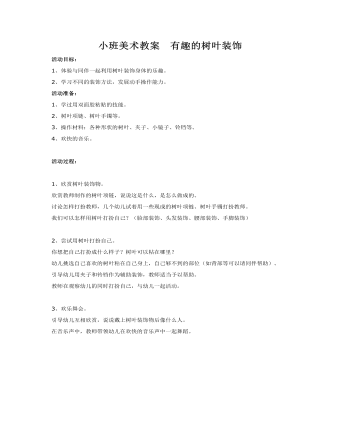
小班美术教案 有趣的树叶装饰
2、学习不同的装饰方法,发展动手操作能力。活动准备:1、学过用双面胶粘贴的技能。2、树叶项链、树叶手镯等。3、操作材料:各种形状的树叶、夹子、小镜子、铃铛等。4、欢快的音乐。 活动过程: 1、欣赏树叶装饰物。欣赏教师制作的树叶项链,说说这是什么,是怎么做成的。讨论怎样打扮教师,几个幼儿试着用一些现成的树叶项链、树叶手镯打扮教师。我们可以怎样用树叶打扮自己?(脸部装饰、头发装饰、腰部装饰、手脚装饰)

综合活动教案有趣的动物房子
活动目标:1.让幼儿根据小动物们的要求,设计出有趣的房子。2.培养幼儿的想像力、创造力。活动准备:1.和幼儿人数相等的16开白纸、马克笔。2.小兔、小松鼠、蝴蝶、大象等图片。活动过程:一.导入活动,激起幼儿兴趣,引出课题“房子”1.老师:小朋友,今天咱们班来了几位小客人,你们看,是谁? 幼儿:小兔、小松鼠、蝴蝶、大象。
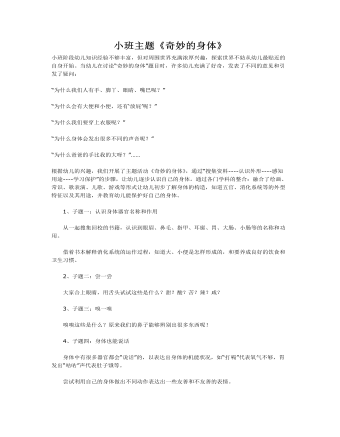
小班主题《奇妙的身体》课件教案
小班阶段幼儿知识经验不够丰富,但对周围世界充满浓厚兴趣,探索世界不妨从幼儿最贴近的自身开始。当幼儿在讨论“奇妙的身体”题目时,许多幼儿充满了好奇,发表了不同的意见和引发了疑问: “为什么我们人有手、脚丫、眼睛、嘴巴呢?”“为什么会有大便和小便,还有‘放屁’呢?”“为什么我们要穿上衣服呢?” “为什么身体会发出很多不同的声音呢?”“为什么爸爸的手比我的大呀?”……
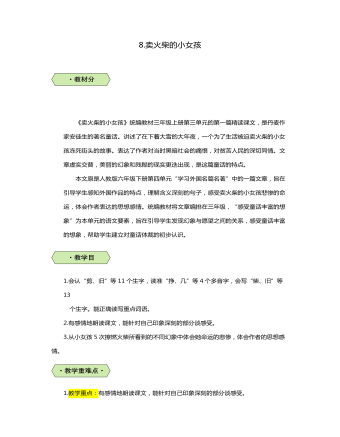
三年级语文卖火柴的小女孩教案
《卖火柴的小女孩》统编教材三年级上册第三单元的第一篇精读课文,是丹麦作家安徒生的著名童话。讲述了在下着大雪的大年夜,一个为了生活被迫卖火柴的小女孩冻死街头的故事。表达了作者对当时黑暗社会的痛恨,对贫苦人民的深切同情。文章虚实交替,美丽的幻象和残酷的现实更迭出现,是这篇童话的特点。本文原是人教版六年级下册第四单元“学习外国名篇名著”中的一篇文章,旨在引导学生感知外国作品的特点,理解含义深刻的句子,感受卖火柴的小女孩悲惨的命运,体会作者表达的思想感情。统编教材将文章编排在三年级,“感受童话丰富的想象”为本单元的语文要素,旨在引导学生发现幻象与愿望之间的关系,感受童话丰富的想象,帮助学生建立对童话体裁的初步认识。
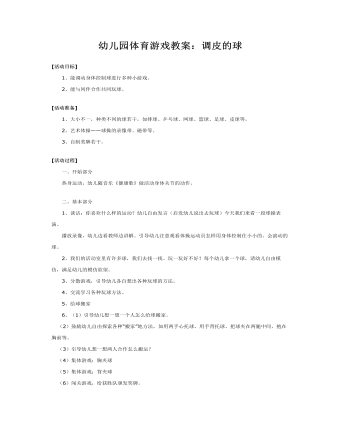
幼儿园体育游戏教案:调皮的球
2、能与同伴合作共同玩球。[活动准备]1、大小不一,种类不同的球若干,如排球、乒乓球、网球、篮球、足球、皮球等。2、艺术体操——球操的录像带、磁带等。3、自制奖牌若干。[活动过程] 一、开始部分 热身运动,幼儿随音乐《健康歌》做活动身体关节的动作。 二、基本部分1、谈话:你喜欢什么样的运动?幼儿自由发言(启发幼儿说出去玩球)今天我们来看一段球操表演。 播放录像,幼儿边看教师边讲解。引导幼儿注意观看体操运动员怎样用身体控制住小小的、会滚动的球。2、我们的活动室里有许多球,我们去找一找、玩一玩好不好?每个幼儿拿一个球,请幼儿自由模仿,满足幼儿的模仿欲望。
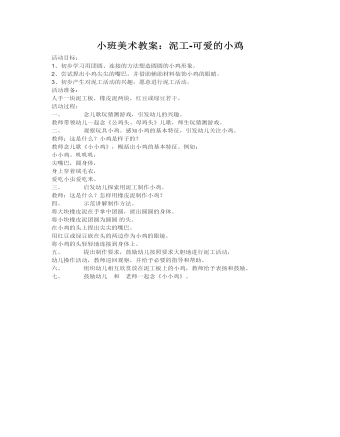
小班美术教案:泥工-可爱的小鸡
2、尝试捏出小鸡尖尖的嘴巴,并借助辅助材料装饰小鸡的眼睛。 3、初步产生对泥工活动的兴趣,愿意进行泥工活动。 活动准备: 人手一块泥工板,橡皮泥两块,红豆或绿豆若干。 活动过程: 一、 念儿歌玩猜测游戏,引发幼儿的兴趣。 教师带领幼儿一起念《公鸡头、母鸡头》儿歌,师生玩猜测游戏。 二、 观察玩具小鸡。感知小鸡的基本特征,引发幼儿关注小鸡。 教师:这是什么?小鸡是样子的? 教师念儿歌《小小鸡》,概括出小鸡的基本特征。例如: 小小鸡。叽叽叽, 尖嘴巴,圆身体, 身上穿着绒毛衣, 爱吃小虫爱吃米。
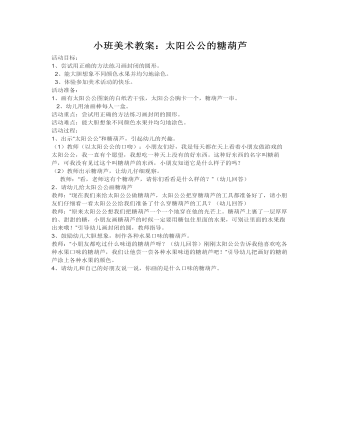
小班美术教案:太阳公公的糖葫芦
活动准备: 1、画有太阳公公图案的白纸若干张,太阳公公胸卡一个,糖葫芦一串。 2、幼儿用油画棒每人一盒。 活动重点:尝试用正确的方法练习画封闭的圆形。 活动难点:能大胆想象不同颜色水果并均匀地涂色。 活动过程: 1、出示“太阳公公”和糖葫芦,引起幼儿的兴趣。 (1)教师(以太阳公公的口吻):小朋友们好,我是每天都在天上看着小朋友做游戏的太阳公公,我一直有个愿望,我想吃一种天上没有的好东西。这种好东西的名字叫糖葫芦,可我没有见过这个叫糖葫芦的东西,小朋友知道它是什么样子的吗? (2)教师出示糖葫芦,让幼儿仔细观察。 教师:“看,老师这有个糖葫芦,请你们看看是什么样的?”(幼儿回答)
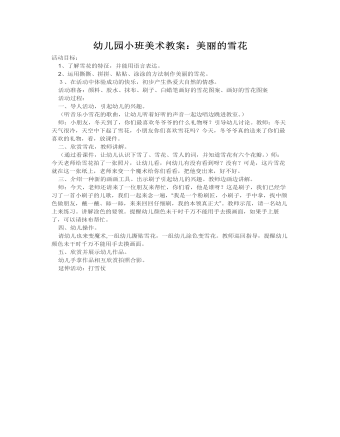
幼儿园小班美术教案:美丽的雪花
2、运用撕撕、拼拼、贴贴、涂涂的方法制作美丽的雪花。 3、在活动中体验成功的快乐,初步产生热爱大自然的情感。 活动准备:颜料、胶水、抹布、刷子、白蜡笔画好的雪花图案、画好的雪花图案 活动过程: 一、导人活动,引起幼儿的兴趣。 (听音乐小雪花的歌曲,让幼儿听着好听的声音一起边唱边跳进教室。) 师:小朋友,冬天到了,你们最喜欢冬爷爷的什么礼物呀?引导幼儿讨论。教师:冬天天气很冷,天空中下起了雪花,小朋友你们喜欢雪花吗?今天,冬爷爷真的送来了你们最喜欢的礼物,看,放课件。 二、欣赏雪花,教师讲解。 (通过看课件,让幼儿认识下雪了、雪花、雪人的词,并知道雪花有六个花瓣。)师:今天老师给雪花拍了一张照片,让幼儿看,问幼儿有没有看到呀?没有?可是,这片雪花就在这一张纸上,老师来变一个魔术给你们看看,把他变出来,好不好。

